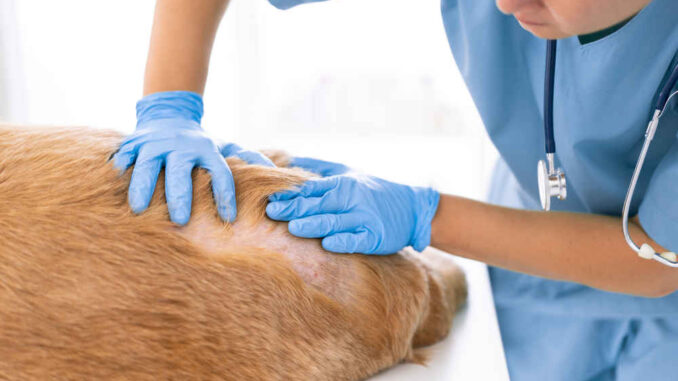
If you spot one or more pustules on your pooch, you’re sure to wonder what is going on and what you can do to help. Having your dog seen at the vet is important, to get to the bottom of their skin disorder.
As I see so many dogs with skin disease on a day to day basis, it is inevitable I come across pustules quite commonly. There can be a range of causes and, how I treat the patient, depends on the underlying cause of their pustules. Here, we take a look at why your dog may have developed pustules and what the most effective treatment would be.
What are pustules?
A pustule is a collection of pus just under the skin, that usually has a clear or yellow color. Pus is a protein rich fluid that consists of dead white blood cells. When pus or pustules are present, this confirms there is a localised infection.
What do pustules on dogs look like?
Below, we can see a dog who has several pustules, and the surrounding skin is red and inflamed. The pustules will be raised in comparison to the surrounding skin, which may feel warm.
There is a yellow colored discharge and we’d expect this dog is feeling itchy and irritated by their skin. We cannot know what has caused these pustules just by looking at them.

On the image below, the pustules are a little less obvious as it seems like a lot of the pus is still below the skin. However, we can see the telltale raised bumps and the red and inflamed skin. The dog in this picture has likely had skin disease and a skin infection for longer than the dog in the first photo above:
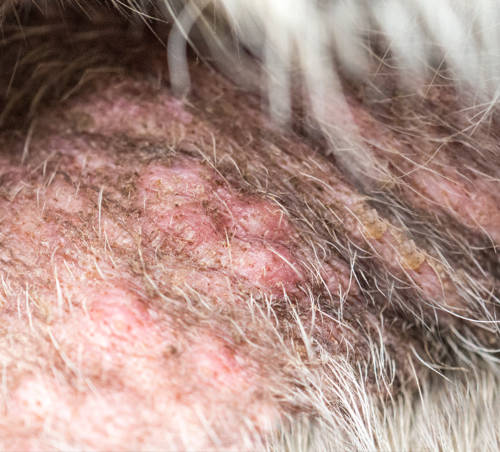
This dog has pustular lesions and this infection was confirmed to be caused by Staphylococcus and to have been triggered by a demodectic mange infection((RVC pustules diagnosis in dermatology)).
Are pustules painful?
There is no doubt that skin infections cause ongoing discomfort and some degree of distress. For some dogs, the itchiness can impact their day-to-day life and even their sleep. When there is a good deal of skin inflammation and redness, there will indeed be some pain.
Are pustules a reason to be worried?
Pustules tell us an infection is present. Infections make a dog feel unwell and also make them uncomfortable. Infections also have the potential to spread. For these reasons, pustules are certainly not something we would ignore.
Oftentimes, pustules are indicative of an underlying medical issue. So, looking into why they have occurred is important.
Top causes of pustules in dogs
1. Pyoderma
A pyoderma is a bacterial skin infection, which is usually caused by Staphylococcus in dogs. There will frequently be a trigger, such as a recent dog bite or scratch or urine scalding. We sometimes see this on puppy’s bellies if they have been nipped or scratched by other members of their litter.
From home, owners should try and address any underlying cause for the infection. This may include flushing out a dog bite or practicing good hygiene for an incontinent dog. A dog bite or any other injury may need to have a drain inserted and the patient will usually be given a course of antibiotics as well as anti-inflammatories or pain relief.
For most dogs, their skin starts to improve within a few days but it is important to finish the course of antibiotics, to prevent the infection from recurring and to avoid the development of antibiotic resistance.
Learn more about pyoderma.
2. Allergic skin disease
Allergies may be environmental (like pollen or dust mites) or to something in the dog’s diet (like beef or chicken). Allergic skin disease means there is a broken skin barrier, and a dog is much more prone to infections and pyoderma. This is especially true as the dog is usually scratching, chewing and licking; introducing bacteria from their mouth and claws. See these pictures below showing of a skin allergic reaction on a dog:
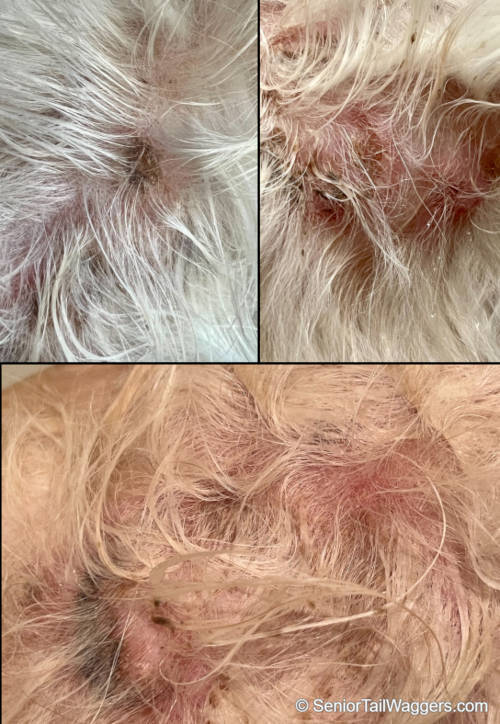
Dogs with allergic skin disease will first become itchy and can later develop signs of skin infection including pustules. The best way to avoid pustules from forming is to manage allergic skin disease as best we can, which can mean a combination of allergen avoidance, medication and medicated washes.
Learn more about skin allergies in dogs.
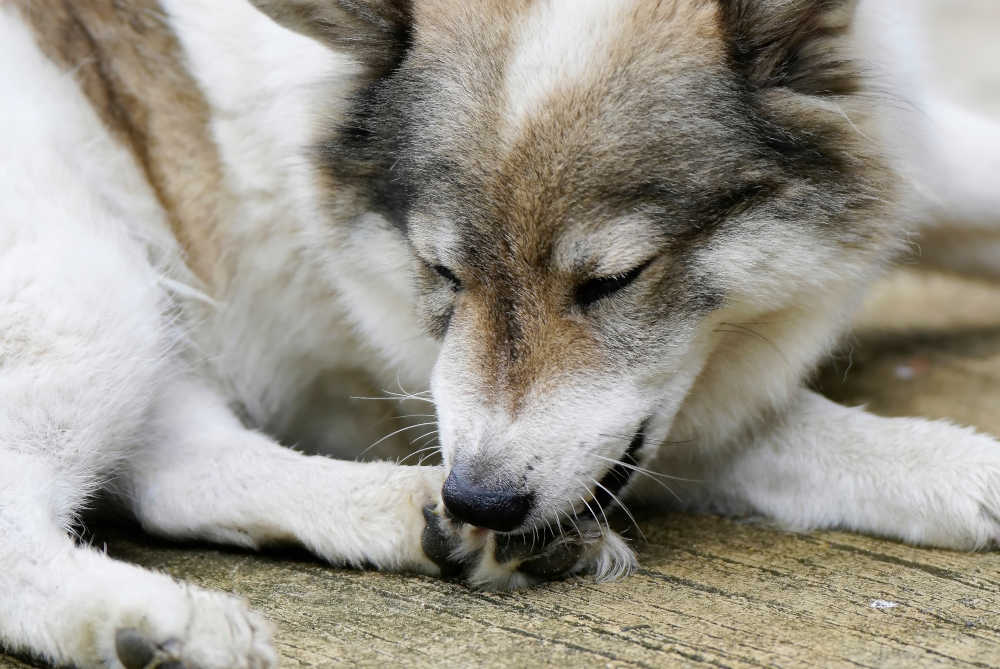
3. Mange
The two most common types of mange in dogs are Demodectic and Sarcoptic. Demodectic mange tends to occur more in puppies and causes less intense itching.
It would not be uncommon for patients to develop secondary skin infections, and these are often overlooked, with the treatment focusing on eliminating the mites. However, if we do not treat the infections and pustules, the dog will continue to be itchy and uncomfortable.
Learn more about Mange.
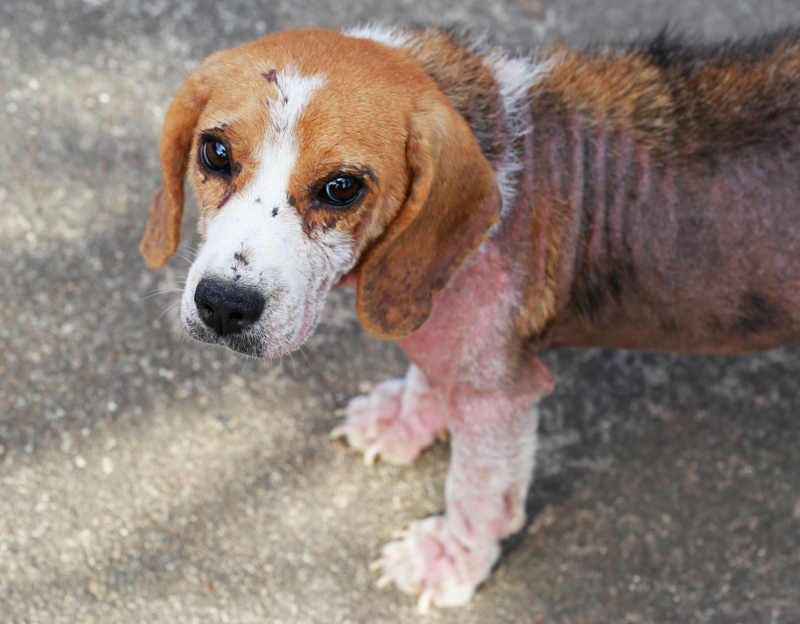
4. Skin fold dermatitis
Each breed is different, and some are made to have lots of skin folds. This is largely due to breeders and owners choosing wrinklier dogs to breed from as they are perceived as ‘cute’. Some good examples of these breeds include the Shar Pei, Bulldog and Pug.
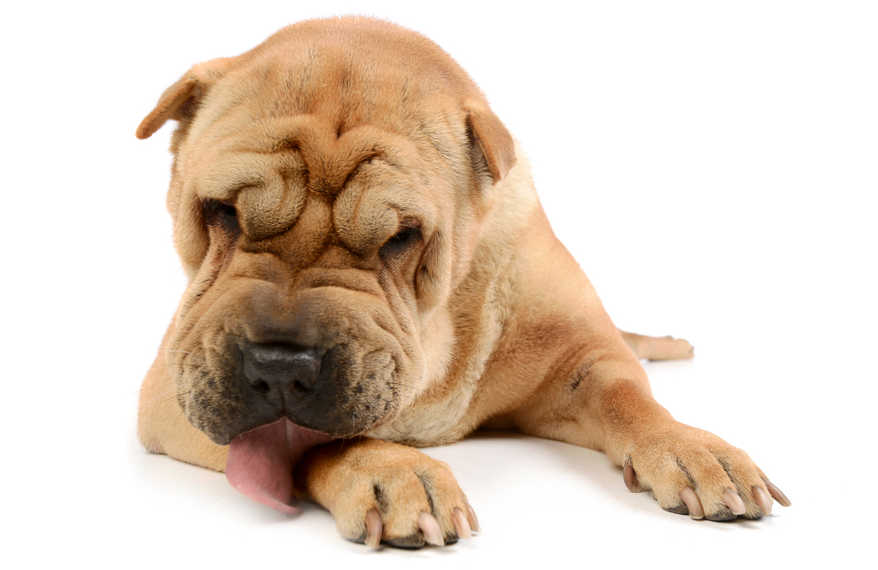
As cute as wrinkles may look, they cause a range of skin issues. The skin within the fold is not well ventilated and becomes moist easily. This can lead to a pyoderma and pustules. Owners may notice the skin in the fold has a bad odor and looks red.
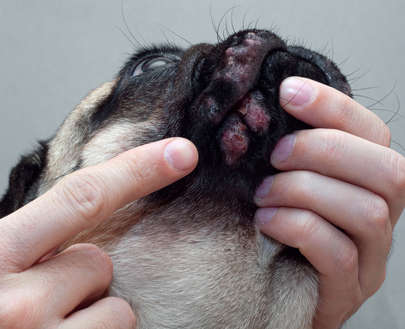
We can prevent skin fold dermatitis by regularly washing and drying a dog’s skin folds. They should be checked daily for any sign of infection. While certain dog breeds will always be prone to skin fold dermatitis, we can prevent infections in a lot of cases.
Learn more about Dog Acne and Pimples.
5. Autoimmune disease such as Pemphigus foliaceous
Autoimmune disorders are relatively rare in dogs. Pemphigus foliaceous is the most common one and the body’s immune system attacks the attachment between the skin cells. Patients tend to be middle-aged and owners will notice they are developing fur loss, scabs, pustules and ulcers. Usually the skin on the head, trunk and paws is worst affected (2).
The treatment will include immune-suppressive drugs such as corticosteroids or cyclosporine. This medicine may be longterm. Secondary infections are then addressed with antibiotics and/or a medicated wash. The prognosis is good for most, but a small number of cases may be refractory to treatment. See this example picture of skin scabs due to autoimmune disease or click here to see another example on Today’s Veterinary Practice.
Learn more about Autoimmune Diseases.
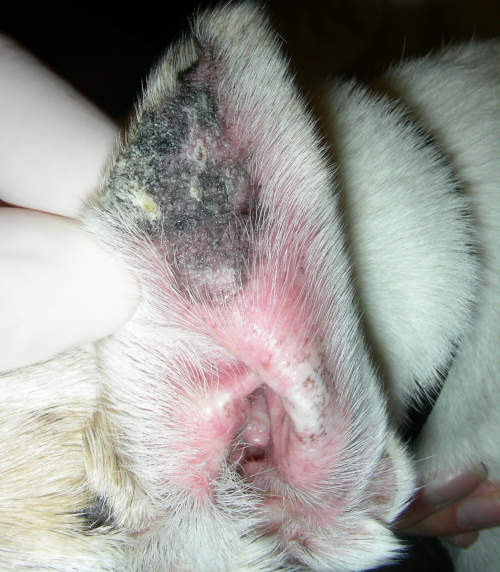
Photo: © Ian Brett Spiegel VMD, MHS, DACVD
How to find out why your dog has pustules
A diagnosis is made by examining the skin and certain diagnostic tests, which may include a skin scrape (to check for mites), skin culture (to determine which bacteria are present) and blood tests (to check for the presence of mites and to assess a dog’s general health).
For skin diseases like pemphigus, a biopsy will usually be required to confirm diagnosis.
Are there effective home remedies that can help dogs with pustules?
While those with pustules will generally need vet care and antibiotics, there are certain things we can do from home. This includes:
- The use of a buster collar to prevent excessive licking and chewing
- Trimming claws short to minimize skin damage from scratching
- Use of washes such as Chlorhexidine regularly
- Good parasite prevention
- Regular cleaning of any skin folds
Risks of trying home remedies
Owners should not rely solely on home remedies when their dog has suspected pustules. An established infection requires antibiotics and delaying treatment can lead to an infection spreading, ongoing discomfort, skin pigment changes and chronic scarring.
Best products to help at home
1. Buster Collar
When a dog has pustules, they will have an urge to lick and chew at the skin. While some owners think this is helpful, it will actually worsen and spread any infection and can make the skin more inflamed.
A soft collar is usually preferable to a hard one, as dogs tolerate them better and find them easier to sleep and rest in. This particular collar is really easy to adjust, ensuring it is a snug fit so cannot be taken off by your dog when they’re left alone.
As dogs can become depressed when wearing collars, they are not a long-term solution and should only be relied upon temporarily as medicine kicks in.
No products found.
2. Chlorhexidine / Hibiclens
A wash like this is great to keep at home and to use on skin that is broken or infected. This diluted skin cleanser is good to use both for cleaning skin folds and for helping to manage established pyoderma and skin pustules. This wash is particularly good at killing off bacteria((Veterinary Surgery Vol 17 Issue 6, Effects of Chlorhexidine Diacetate and Povidone-lodine on Wound Healing in Dogs)).
This bottle is easy to use thanks to its pump action and can be squirted directly on to some cotton wool or gauze before rinsing with water, to make an impregnated wipe.
- Trusted by Healthcare: Hibiclens Antiseptic Skin Cleanser has been a trusted product among many hospitals and care centers for over 40 years as a skin cleanser in pre-operative patient bathing, and for help in reducing the risk of surgical site infections
Signs that you need to call your veterinarian
Schedule your vet visit as soon as you suspect your dog has a skin infection or pustules. Seeing pustules confirms the presence of an infection, and the sooner we treat it, the better.
For those whose dogs are prone to skin issues (such as dogs with atopic skin disease or skin folds), they may first notice the skin is red and itchy. At this point, mild signs may be treated from home. However, if the itching is persisting or we are seeing signs of infection, the dog will need to be seen.
Your visit at the vet
Questions your vet will ask you
Your vet will want to know about any previous skin issues and whether or not your dog has had pustules in the past. They will ask about any signs such as itchiness or red skin that you’ve noticed.
They will also enquire if your dog is up to date with their parasite prevention and will ask if anyone at home or any other pets seem to be affected.
You should tell the vet about any products you’ve tried so far and any recent changes in your dog’s diet and environment.
What you should know before your visit
Some owners find their dog’s skin looks worse at certain times, so it can be a good idea to take a photo or video of what is concerning you. It is also worth taking a photo before cleaning the skin, if you are planning to clean it right before your vet visit.
Diagnosis & cost of diagnosis
For mild one-off cases of skin pustules, your vet may not run many tests and simply skip straight to treatment. However, if your vet is concerned for an underlying issue or the pustules continue to recur, they may suggest a skin work-up. Diagnosis can include tests such as a skin swab ($150), skin scrape ($50-100) and/or skin biopsy ($400-600)
Treatments and costs
Treatment will inevitably consist of antibiotics, which will last several weeks. The cost will depend on which antibiotic is needed and the weight of the patient. We are generally looking at $50-150. As well as antibiotics, your vet are likely to issue a medicated wash ($30-50).
Prognosis
The prognosis for uncomplicated cases is excellent, with most dogs’ skin clearing up in a matter of weeks. However, when there are underlying medical issues, this can complicate things and make the prognosis worse.
FAQ
Is a pustule the same as a blister?
No, they are two entirely different things. A pustule is a collection of pus under the skin. A blister is a swelling filled with watery liquid or serum.
Is a pustule on my dog the same thing as a pimple?
We don’t usually use this term in veterinary medicine, but humans use the word ‘pimple’ to describe pus filled bumps, so they would be the same thing.
Is a papule the same thing as a pustule?
No, a papule is a solid lump, usually containing inflammatory cells. They do not contain pus.
Can pustules be contagious?
Pustules are usually attributed to Staphylococcus overgrowth, and bacterial infections can potentially be passed on. However, this is uncommon as it would usually entail a dog rubbing an open pustule against another dog or person with broken skin. Still, it is important to practice good hygiene and wash hands well after touching or cleaning a dog with pustules.
References:
- https://www.rvc.ac.uk/review/dermatology/lesions/pustules.htm#:~:text=In%20dogs%2C%20the%20most%20important,in%20origin%20until%20proven%20otherwise!
- https://meridian.allenpress.com/jaaha/article-abstract/42/3/189/176040/Pemphigus-Foliaceus-in-91-Dogs
- https://onlinelibrary.wiley.com/doi/abs/10.1111/j.1532-950X.1988.tb01019.x
Disclaimer: This website's content is not a substitute for veterinary care. Always consult with your veterinarian for healthcare decisions. Read More.



Be the first to comment